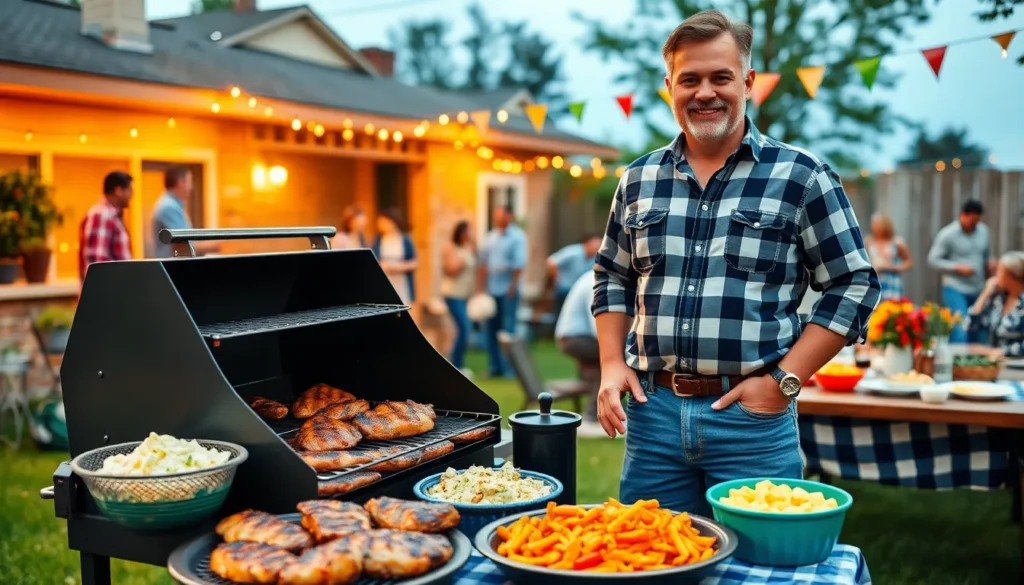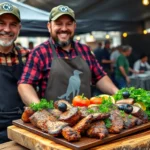Nothing beats the sizzle of a perfectly grilled feast when you’re feeding a hungry crowd. We’ve all been there – staring at a guest list that keeps growing while wondering how we’ll possibly satisfy everyone’s appetite without very costly or spending all day at the grill.
Planning BBQ meals for a crowd doesn’t have to be overwhelming. With the right recipes and smart preparation strategies we can turn any gathering into an unforgettable feast that’ll have your guests talking for weeks. From budget-friendly bulk proteins to crowd-pleasing sides that practically cook themselves we’ve cracked the code on stress-free entertaining.
Whether you’re hosting a backyard birthday bash family reunion or neighborhood block party we’ll show you how to master the art of large-scale grilling. Get ready to become the BBQ hero your friends and family never knew they needed.
Plan Your BBQ Menu Around Crowd-Friendly Proteins
Selecting the right proteins forms the foundation of any successful crowd BBQ event. We’ve found that choosing meats that stretch your budget while satisfying hungry guests makes all the difference in hosting memorable gatherings.
Pulled Pork: The Ultimate Make-Ahead Option
Pulled pork delivers exceptional value when feeding large crowds, typically serving 3-4 people per pound of raw pork shoulder. We recommend smoking a 8-10 pound Boston butt roast to comfortably feed 25-30 guests, which costs significantly less than premium cuts like ribeye or tenderloin.
Starting your pulled pork 12-16 hours before the event allows the meat to develop rich flavors while you focus on other preparations. We slow cook pork shoulders at 225°F until they reach an internal temperature of 205°F for perfect shredding consistency.
Make ahead convenience lets you store pulled pork in slow cookers or warming trays during the party, keeping it moist and ready to serve. Guests can customize their portions with various BBQ sauces, coleslaw, and pickles, creating personalized sandwiches that satisfy different taste preferences.
Smoked Brisket for Large Groups
Smoked brisket creates an impressive centerpiece for serious BBQ crowd events, though it requires more planning than other protein options. We calculate approximately 1/2 pound of raw brisket per person, meaning a 12-pound whole packer brisket feeds about 20-24 guests after trimming and cooking loss.
Low and slow cooking transforms tough brisket into tender, flavorful meat that guests remember long after the event ends. We maintain smoker temperatures between 225-250°F for 12-16 hours, depending on the brisket size and desired doneness level.
Proper slicing technique ensures every guest receives quality portions, with lean and fatty sections distributed evenly across servings. We slice against the grain in 1/4 inch thick pieces, separating the point and flat muscles for optimal texture and presentation.
Grilled Chicken Pieces That Feed Everyone
Grilled chicken pieces offer the most budget friendly protein option for large BBQ gatherings, typically costing 40-50% less than beef or pork alternatives. We purchase whole chickens and break them down into thighs, drumsticks, breasts, and wings to maximize value while providing variety for different preferences.
Dark meat pieces like thighs and drumsticks stay juicy on the grill longer than white meat, making them ideal for crowd cooking where timing varies. We marinate chicken pieces 4-24 hours before grilling to enhance flavors and ensure tender results across all cuts.
Batch grilling allows us to cook large quantities efficiently, using indirect heat zones to prevent burning while maintaining proper internal temperatures of 165°F. We arrange pieces by size and cooking time requirements, starting with larger thighs and drumsticks before adding quicker cooking wings and breast pieces.
Prepare Side Dishes That Complement Your BBQ Spread
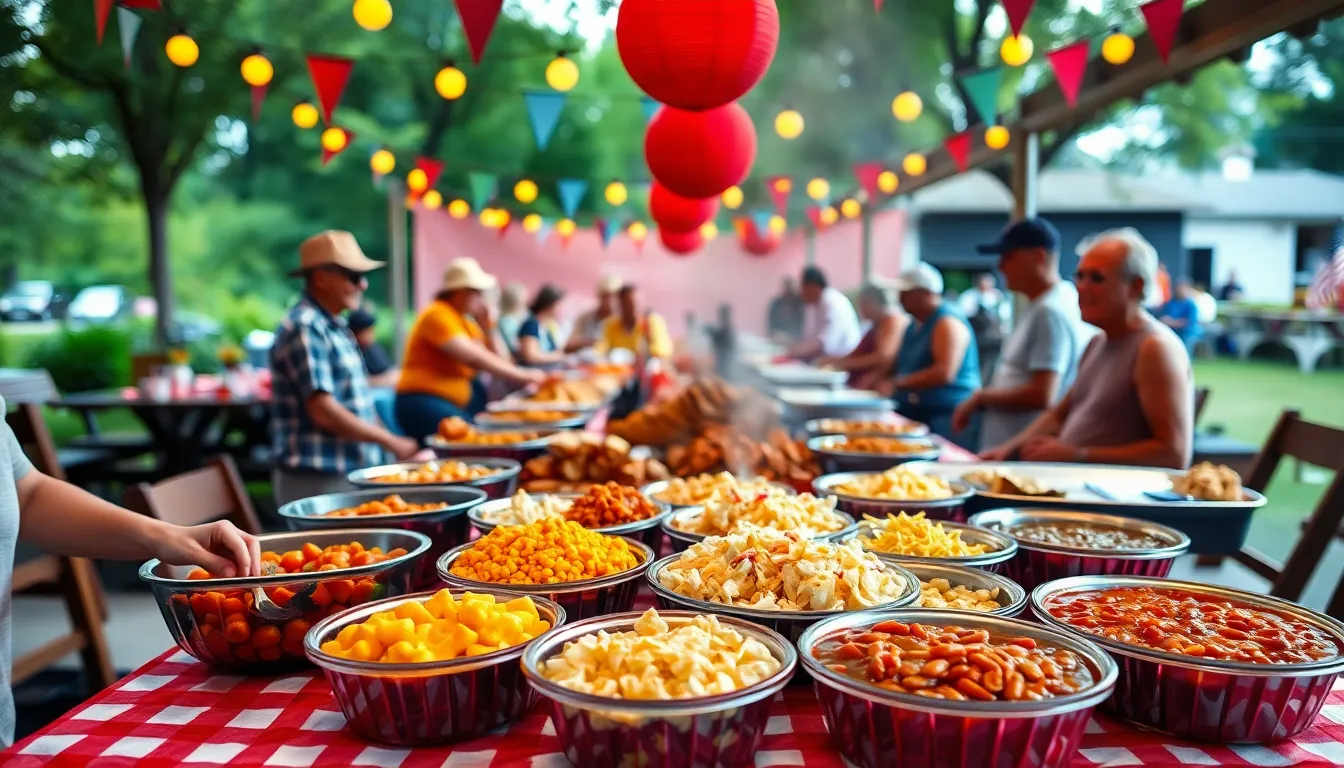
Once you’ve mastered your proteins, the right side dishes transform your BBQ into a complete feast. Strategic planning for sides ensures balance in textures and flavors while keeping preparation manageable for large groups.
Mac and Cheese for the Masses
Mac and cheese delivers the ultimate crowd-pleasing comfort food that scales perfectly for large gatherings. Our go-to recipe for 20-25 people uses 1 cup butter, 1 cup flour, 8 cups milk, 8 cups shredded cheese, and 48 oz cooked elbow macaroni.
Start by melting butter in a large pot, then whisk in flour and cook until fragrant. Gradually add warm milk to create a smooth roux, stirring constantly to prevent lumps. Stir in cheese until completely melted and creamy, then combine with your cooked and drained pasta.
Transfer everything to large casserole dishes for baking, which allows even heating and easy serving. This method produces consistently creamy results that hold up well during extended serving periods.
Coleslaw That Stays Fresh All Day
Coleslaw provides the perfect crisp contrast to rich BBQ flavors when prepared correctly for crowds. Build your base with sturdy vegetables like cabbage and carrots that won’t wilt quickly under dressing.
Prepare vegetables in advance but keep dressing separate until just before serving time. This technique prevents sogginess and maintains that essential crunch throughout your event.
Choose either vinegar-based or mayonnaise-based dressing depending on your preference, but always dress the slaw close to serving time. Fresh preparation ensures maximum texture and flavor impact for your guests.
Baked Beans in Large Batches
Baked beans offer the ideal make-ahead side that actually improves with time and gentle reheating. Large batch recipes typically combine canned beans, tomato sauce, molasses or brown sugar, mustard, and your preferred spices.
Mix all ingredients in a large roasting pan or slow cooker for hands-off cooking that develops deep, complex flavors. This method allows beans to simmer slowly while you focus on other BBQ preparations.
Keep finished beans warm in slow cookers or warming trays throughout your event. Extended gentle heating continues flavor development while ensuring food safety for extended serving periods.
Calculate Portions to Avoid Running Out of Food
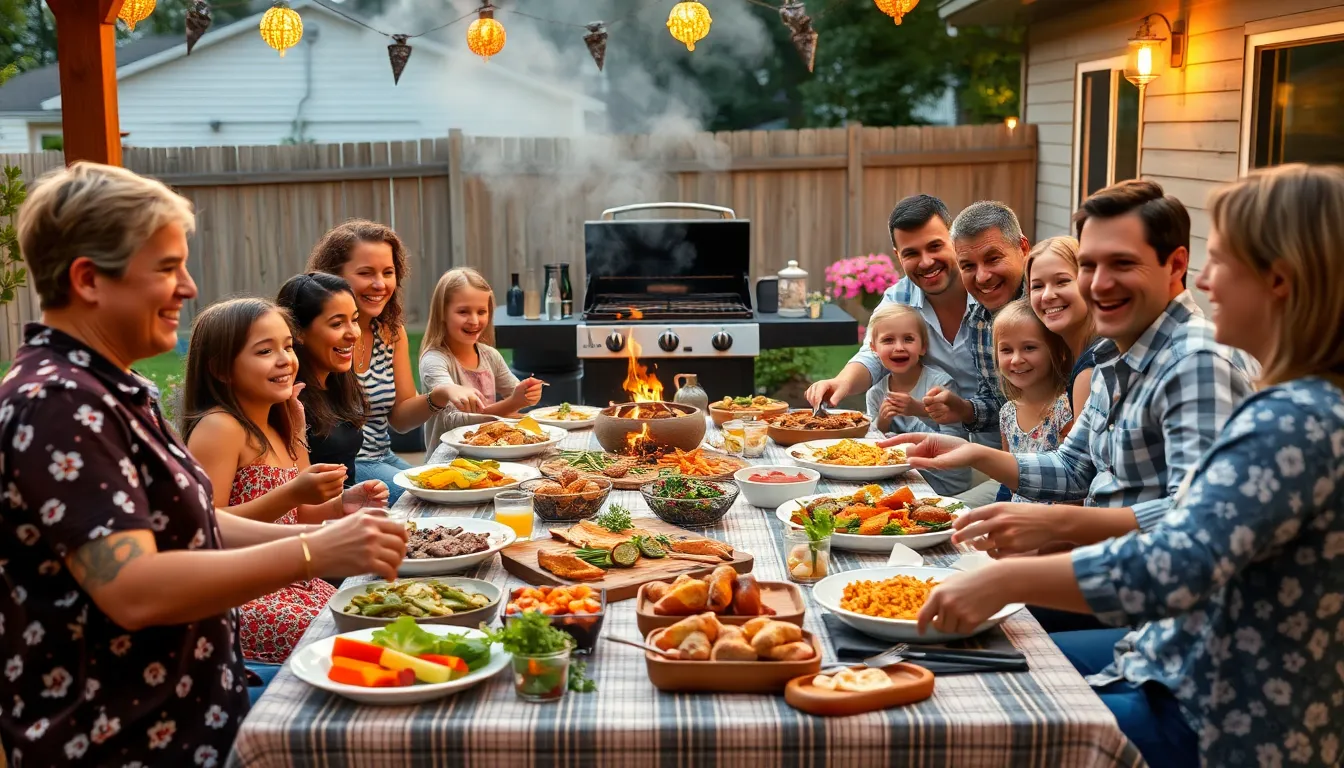
Now that we’ve covered the perfect proteins and sides, let’s tackle the most critical aspect of BBQ planning: getting the portions right to feed everyone without waste.
Meat Portions Per Person Guidelines
General BBQ events require ¼ to ⅓ pound of meat per adult when you’re serving multiple sides, since guests will fill up on coleslaw, beans, and other accompaniments. We recommend this conservative approach for most casual gatherings where people graze throughout the event.
BBQ plates with multiple meat options need ½ to ⅓ pound per person according to expert caterers who specialize in brisket and sausage combinations. This range accounts for guests sampling different proteins rather than loading up on just one type.
Better Homes & Gardens suggests 8 to 12 ounces of raw meat per adult (½ to ¾ pound) for hearty eaters, while children typically need 4 to 6 ounces. We find this guideline works well for events where BBQ is the main attraction.
Professional caterers often use the “1 pound for every 3 people” rule when serving variety platters, since offering multiple meat types naturally reduces consumption per individual protein. This approach maximizes satisfaction while controlling costs.
Buffet style events demand ½ to ¾ pound of meat per person because guests can return for seconds, while plated dinners require only 6 to 8 ounces since portions are controlled. We adjust our planning based on serving style to avoid shortages.
Side Dish Serving Size Estimates
Side dishes balance the meal and reduce meat consumption by providing filling alternatives that satisfy different tastes and dietary needs. We’ve found that generous sides actually help stretch the meat budget.
Plan for 4 to 6 ounces per person for each side dish you’re serving, whether it’s mac and cheese, coleslaw, or baked beans. This portion size ensures everyone gets enough without creating excessive leftovers.
Include variety in your side selection with options like salads, beans, coleslaw, and bread to satisfy different preferences and increase overall satiety. We recommend offering at least three different sides to create a well rounded spread.
Planning for Different Appetite Levels
Adult guests typically eat more meat than our base estimates especially men and heavy eaters who view BBQ as the main event. We adjust portions upward by 10–20% when expecting big appetites at the gathering.
Children consume approximately half the adult portion so factor this into your calculations when families are attending. This adjustment helps prevent over ordering while ensuring the kids have plenty to eat.
Events with drinking and casual grazing allow for lower meat estimates since guests often fill up on sides, snacks, and appetizers throughout the day. We lean toward conservative portions for these relaxed gatherings where people eat at their own pace.
Choose Equipment That Handles Large Quantities
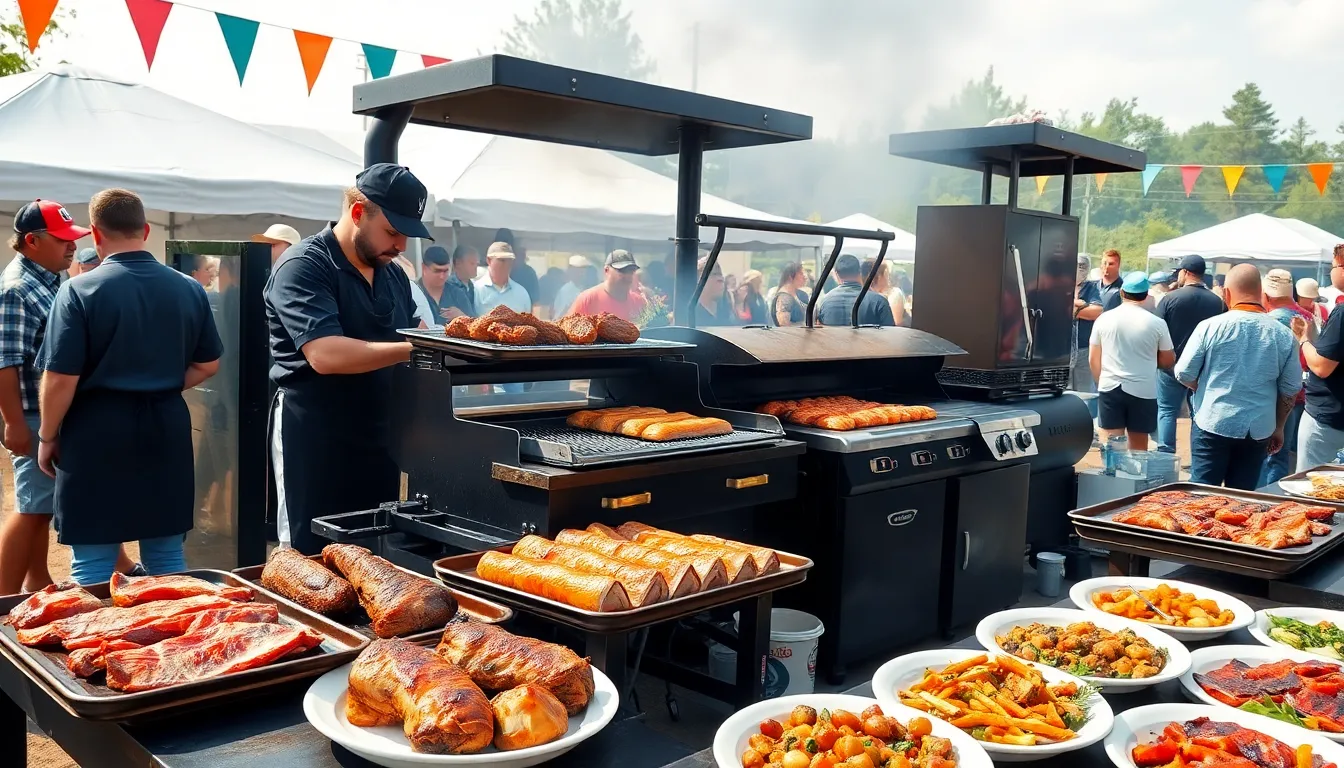
When feeding large crowds, the equipment you choose can make or break your BBQ event. Heavy-duty commercial grills and smokers built from top-grade American steel offer the capacity and durability needed for sustained use with large groups.
Multiple Grill Setup Strategies
Combining different grill types gives you the flexibility to cook various foods simultaneously while maintaining steady output. Commercial charbroilers paired with griddles allow you to prepare meats on one surface while cooking sides like vegetables or breakfast items on another. Multiple smokers working in tandem ensure continuous cooking flow without bottlenecks that could delay service.
Configuring equipment with multiple racks maximizes your cooking space efficiently. We recommend setups that include adjustable shelving systems to accommodate different food sizes and cooking requirements. This approach lets you manage large quantities without compromising on quality or timing.
Smoker Options for Big Batches
High-capacity commercial smokers handle the volume demands of crowd cooking with minimal supervision. Models like the Oyler Pit and Big M smoker can cook hundreds to thousands of pounds unattended through controlled airflow and precise temperature regulation. These units deliver consistent results while maintaining that authentic smoky flavor throughout large batches.
Commercial vertical gas smokers provide the temperature control and multiple cooking grates needed for reliable slow smoking. We find these particularly effective for large protein volumes because they offer precise heat management across multiple levels simultaneously.
Serving and Warming Equipment Essentials
Holding cabinets and warming trays maintain food quality during extended service periods without compromising texture or flavor. Commercial food warming equipment keeps cooked BBQ at safe temperatures while preserving the integrity of your carefully prepared dishes.
Portable BBQ trailers with mounted grills, sinks, and storage help on-site cooking and serving for large events. These mobile units enhance efficiency and service quality by bringing professional-grade equipment directly to your venue location.
Master the Timeline for Stress-Free Cooking
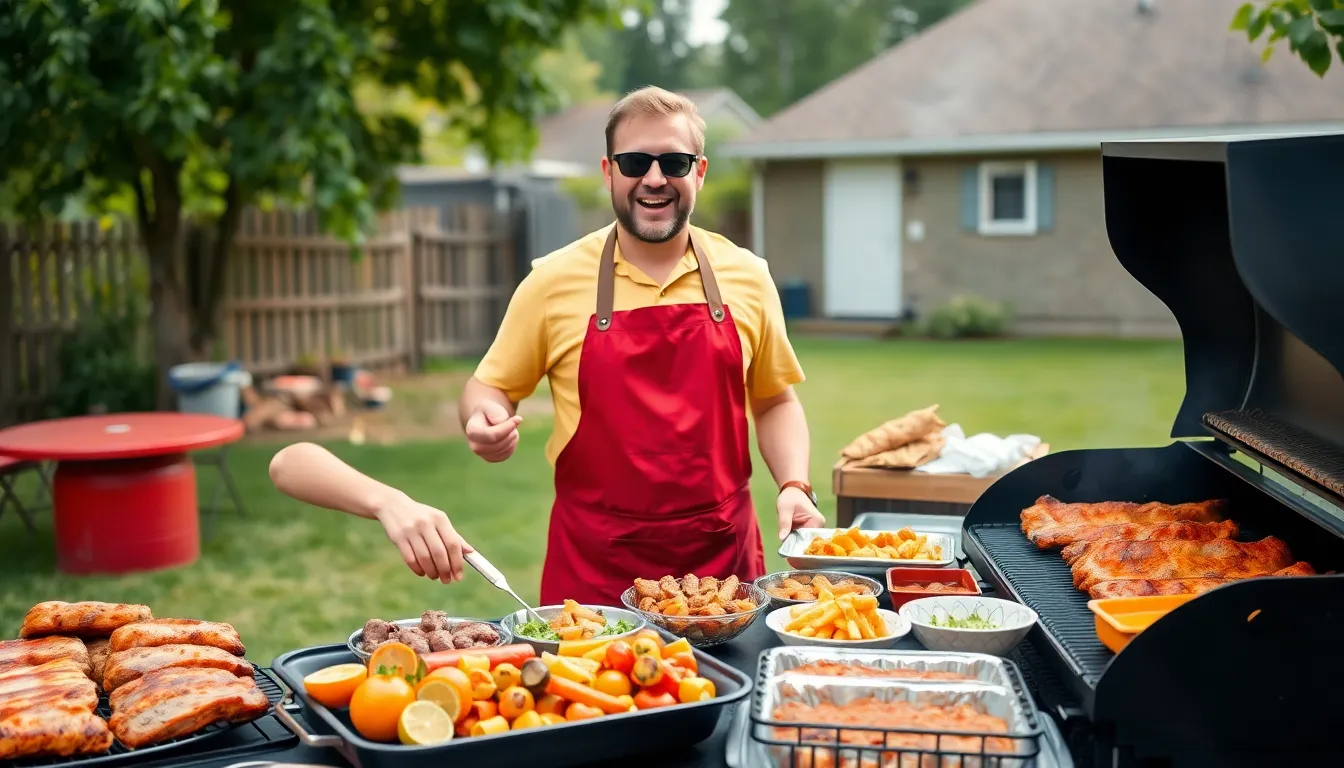
Successful BBQ events for crowds require strategic timing that starts well before your guests arrive. We’ll break down the essential phases to ensure your BBQ runs smoothly from preparation to serving.
Day-Before Prep Tasks
Planning creates the foundation for stress-free BBQ cooking when we develop a comprehensive game plan. We need to compile detailed checklists covering packing essentials, to-do items, and meat specifications with seasoning notes. Creating a cooking schedule helps us visualize the entire timeline and identify potential bottlenecks.
Menu calculations eliminate guesswork when we determine exact quantities based on our guest count. We multiply ingredients systematically for every menu component including meats, sides, condiments, and buns. Exact quantities listed for each item prevent last-minute grocery runs and ensure we have adequate supplies.
Meat preparation begins early since many BBQ proteins require extended cooking times that often start the night before. We can season briskets and Boston butts, allowing flavors to penetrate overnight. Large cuts benefit from this advance preparation, making our event day schedule more manageable.
Morning of Event Schedule
Early starts accommodate long cooking times for substantial cuts like 10-pound Boston butts that need approximately 14 hours total time including prep and resting. We typically begin at 4:30 a.m. for a 6:30 p.m. serving to ensure proper doneness. This timing provides buffer space for temperature adjustments or cooking delays.
Smoker management requires consistent attention once we light the equipment and achieve our target temperature of 250°F. We monitor the cooking process throughout the day, maintaining steady heat levels for optimal results. Temperature fluctuations can significantly impact cooking times and meat quality.
Additional preparation maximizes efficiency while our meats cook slowly on the smoker. We use this extended timeframe to prepare side dishes, assemble non-meat components, and organize serving areas. Multitasking during cooking hours prevents last-minute rushes.
Last-Minute Assembly Tips
Proper resting preserves meat quality when we allow cooked proteins to rest for approximately two hours before slicing. We maintain temperature while letting juices redistribute throughout the meat. This crucial step prevents dry, tough results that disappoint guests.
Strategic setup streamlines service by allocating 30 minutes before serving for final food preparation and buffet arrangement. We position condiments, buns, and sides for easy guest access in self-service configurations. Clear labeling and proper serving utensils enhance the dining experience.
Buffer time prevents disasters when we build at least one hour of flexibility into our timeline for unexpected delays. We account for temperature adjustments, equipment issues, or cooking variations that commonly occur. This cushion transforms potential stress into confident execution.
Set Up Efficient Serving Stations for Crowds

Organizing your serving stations strategically transforms a chaotic feeding situation into a smooth, enjoyable experience for everyone. We’ll create a flow that keeps guests moving while maintaining food quality throughout your event.
Buffet-Style Layout Design
Position buffet tables away from walls so guests can access food from both sides, effectively doubling your serving speed. This simple adjustment reduces wait times significantly when feeding large groups.
Create multi-level displays using risers and stands to vary dish heights, maximizing table space while adding visual appeal to your spread. Elevated platforms showcase your BBQ creations and make it easier for guests to see all available options.
Design your layout in “figure 8” or “H” shapes for crowds exceeding 50 people, allowing continuous traffic flow without bottlenecks. These configurations prevent the single-file line nightmare that kills party momentum.
Maintain walkway widths of at least 30 inches around all serving tables to ensure comfortable movement even when guests pause to make selections. Cramped spaces create frustration and slow down the entire serving process.
Incorporate serpentine or curved table arrangements to break up long lines and distribute crowding more evenly throughout your serving area. Curved layouts feel more natural and reduce the institutional cafeteria vibe.
Self-Service Condiment Stations
Establish separate condiment stations positioned away from main food areas to prevent cross-traffic congestion between guests getting food and those adding toppings. We recommend placing these stations near seating areas for easy access.
Stock a comprehensive variety of sauces and toppings with clear labels identifying each option, including any dietary restrictions or allergen information. Guests appreciate knowing what they’re choosing without having to ask.
Include dedicated utensils and serving tools at each condiment station to prevent guests from backtracking to the main serving area. Small tongs, spoons, and squeeze bottles keep everything sanitary and moving smoothly.
Arrange condiments in logical groupings such as BBQ sauces together, fresh toppings in another section, and pickled items in their own area. This organization helps guests find what they want quickly.
Traffic Flow Considerations
Mark the buffet line’s start and end points clearly with signs or table arrangements, placing plates, napkins, and utensils together at the beginning to guide guest movement naturally. Clear entry points eliminate confusion and false starts.
Arrange dishes in logical progression from appetizers to main BBQ items to sides and desserts, following the natural flow of meal construction. This sequence prevents guests from having to double back for forgotten items.
Create dedicated one-way flow paths with separate entry and exit points whenever possible to minimize crowding and guest collisions. Directional signage helps maintain this flow during busy periods.
Label all food items comprehensively including dish names, key ingredients, and dietary restriction notes to help guests make quick decisions without slowing the line. Detailed labels reduce questions and keep traffic moving.
Space serving stations adequately so guests can circulate comfortably without creating waiting clusters around popular items. We recommend at least 6 feet between major serving areas to prevent backup situations.
Keep Food Safe During Extended Outdoor Events

When hosting BBQ meals for large groups, food safety becomes our top priority to ensure everyone enjoys the meal without any health risks. Extended outdoor events present unique challenges that require careful attention to temperature control and proper food handling practices.
Temperature Control Guidelines
Monitor the danger zone carefully to prevent foodborne illness during your BBQ event. Foods must not remain between 40°F and 140°F for more than 2 hours, or just 1 hour when outdoor temperatures exceed 90°F. Hot foods should be maintained at or above 140°F using insulated containers or warming trays throughout the serving period. Cold perishable items require temperatures at 40°F or below, which we can achieve by storing them in ice-filled coolers.
Use a clean, calibrated probe thermometer to regularly check food temperatures during storage, cooking, and holding phases. We recommend checking temperatures every 30 minutes during extended events to ensure foods remain in safe temperature ranges. Digital thermometers provide the most accurate readings and help us make quick decisions about food safety.
Food Storage Best Practices
Store cold perishables in ice-filled coolers at 40°F or below until serving time arrives. Items like chicken salad can be placed directly on ice or in shallow dishes nested within deeper pans filled with ice. Drain melted ice water regularly and replace with fresh ice to maintain proper temperatures throughout the event.
Keep hot foods wrapped in insulated containers until we’re ready to serve them to guests. These containers help maintain safe temperatures for several hours while preserving food quality and flavor. We should avoid opening containers frequently, as this allows heat to escape and compromises food safety.
Prevent cross-contamination by using separate cutting boards, plates, and utensils for raw and cooked foods. Never reuse plates or utensils that previously held raw meats, poultry, or seafood for serving cooked foods unless they’ve been thoroughly washed in hot, soapy water.
Timing for Perishable Items
Discard perishable items that have been left out beyond the 2-hour limit, or 1 hour when temperatures exceed 90°F. This strict timeline helps prevent bacterial growth that can cause foodborne illness among our guests. We must remain vigilant about timing, especially during hot summer BBQ events.
Plan preparation and serving schedules to minimize the time food spends outside safe temperature ranges. Stagger cooking times so foods finish close to serving time rather than sitting out for extended periods. We should also prepare a timeline that accounts for peak serving periods and adjust our food safety practices accordingly.
Check expiration dates on all perishable items before the event and prioritize using items closest to their expiration dates first. Any food that shows signs of spoilage or has exceeded safe holding times should be thrown away immediately, regardless of cost or preparation effort.
Budget-Friendly Strategies for Large Group BBQs

Smart spending decisions can transform your large BBQ gathering from a financial burden into an affordable celebration. We’ll show you how to maximize flavor while minimizing costs through strategic protein selection, bulk purchasing, and clever menu planning.
Cost-Effective Protein Choices
Chicken thighs deliver exceptional value compared to premium cuts while maintaining rich flavor profiles that satisfy crowds. We recommend purchasing these darker meat portions because they stay moist during extended cooking periods and cost significantly less than breasts or steaks.
Pork shoulder represents the ultimate budget-friendly centerpiece for feeding large groups effectively. This versatile cut transforms into pulled pork that serves 3-4 people per pound, stretching your protein budget further than individual steaks or chops.
Sausages provide instant crowd appeal without requiring extensive preparation time or premium pricing. We suggest offering a variety of flavors to accommodate different tastes while keeping per-serving costs low.
Whole chickens and larger brisket cuts offer better value when purchased intact rather than pre-cut portions. Breaking down these proteins yourself saves money while providing flexibility in serving sizes and cooking methods.
Vegetarian protein options like grilled portobello mushrooms or veggie burgers help balance your menu without overbuying expensive meats for every guest.
Bulk Buying Tips
Warehouse clubs and wholesale suppliers offer important savings when purchasing proteins and sides in large quantities. We recommend calculating per-pound costs to identify the best deals on your essential BBQ ingredients.
Planning quantities carefully ensures you buy enough without waste, typically requiring ½ to ¾ pound of meat per person depending on your side dish selection. This formula helps prevent overbuying while guaranteeing adequate portions for everyone.
Staple ingredients like beans, coleslaw components, and cornbread supplies cost substantially less when purchased in bulk packaging. We suggest coordinating with other hosts or freezing extras for future events to maximize these savings.
Buying complete cases of items like BBQ sauce, rubs, and condiments often triggers wholesale pricing that reduces your per-unit costs significantly.
Money-Saving Menu Planning
Simple menus with strategic variety keep costs manageable while satisfying diverse preferences through 2-3 protein options and affordable sides like coleslaw, baked beans, and corn. We focus on dishes that complement each other without requiring expensive specialty ingredients.
Make-ahead preparation reduces day-of stress while optimizing your time and energy costs through advance marinating, vegetable chopping, and sauce preparation. This approach allows you to spread workload across multiple days instead of rushing expensive last-minute purchases.
Self-serve buffet arrangements minimize labor costs while encouraging guests to customize their plates according to personal preferences. We recommend positioning drinks and desserts in accessible areas to reduce serving complexity and associated expenses.
Strategic recipe selection emphasizes dishes requiring minimal active cooking time on event day, reducing energy costs and freeing you to focus on guest interaction rather than constant food management.
Conclusion
Hosting a successful BBQ for a crowd doesn’t have to be overwhelming when you’ve got the right strategy in place. We’ve shown you how smart planning and preparation can transform what seems like a challenging job into an enjoyable experience that’ll have your guests talking for weeks.
The key to BBQ success lies in mastering three essential elements: choosing the right proteins that feed many people efficiently scheduling your prep work to avoid last-minute stress and creating a budget that won’t expensive. When you combine make-ahead sides with cost-effective cuts like pork shoulder and chicken thighs you’re setting yourself up for victory.
Remember that great BBQ hosting isn’t about perfection – it’s about bringing people together over delicious food. With these strategies in your back pocket you’re ready to fire up that grill and create memorable moments that’ll keep everyone coming back for more.
Frequently Asked Questions
How much meat should I plan per person for a large BBQ?
Plan ¼ to ⅓ pound of meat per adult when serving multiple sides. For buffet-style events, increase to ½ to ¾ pound per person. Plated dinners require only 6-8 ounces per person. Adjust portions based on your guest demographics, with children typically eating smaller portions than adults.
What are the best budget-friendly proteins for crowd BBQs?
Chicken thighs, pork shoulder, and sausages offer excellent flavor without breaking the bank. Pulled pork is particularly cost-effective, serving 3-4 people per pound. These cuts are forgiving to cook and can be enhanced with various sauces and seasonings to please different tastes.
How far in advance can I prepare BBQ sides?
Most sides can be prepared 1-2 days ahead. Coleslaw stays fresh when prepped in advance, baked beans actually improve with time, and mac and cheese can be assembled early and baked on event day. This advance preparation reduces day-of stress significantly.
What equipment do I need for cooking BBQ for 50+ people?
Invest in heavy-duty commercial grills or multiple standard grills for capacity. High-capacity smokers work well for large volumes with minimal supervision. Consider warming trays or holding cabinets to maintain food temperature during extended service periods.
How do I create a cooking timeline for large group BBQ?
Start meat prep the day before, especially for long-cooking proteins like brisket. Begin smoking early morning on event day. Create detailed checklists and cooking schedules. Build in buffer time for unexpected delays and allow meats to rest before serving.
What’s the best serving setup for large BBQ gatherings?
Self-serve buffet arrangements work best for large groups. Set up serving stations strategically to prevent bottlenecks. Keep hot foods in warming trays and cold sides properly chilled. This setup reduces labor costs and allows guests to customize their plates.
How can I save money when BBQing for a crowd?
Buy in bulk from warehouse clubs and coordinate purchases with other hosts. Choose simple menus with strategic variety. Focus on make-ahead dishes and cost-effective proteins. Self-serve setups eliminate the need for additional serving staff.
What side dishes work best for large BBQ events?
Mac and cheese, coleslaw, and baked beans are crowd favorites that scale well. Plan 4-6 ounces per person for each side dish. Offer variety in textures and flavors to complement rich BBQ meats and satisfy different dietary preferences.

